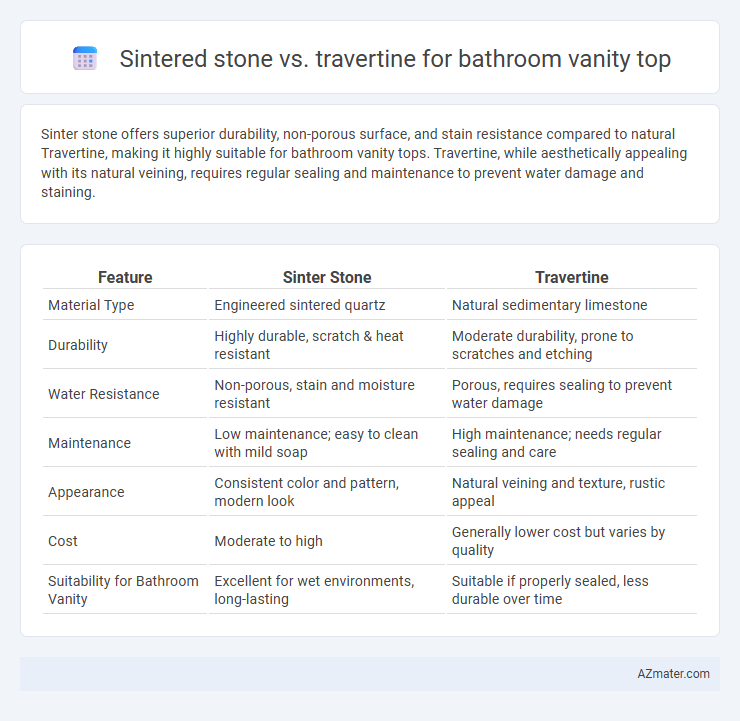Sinter stone offers superior durability, non-porous surface, and stain resistance compared to natural Travertine, making it highly suitable for bathroom vanity tops. Travertine, while aesthetically appealing with its natural veining, requires regular sealing and maintenance to prevent water damage and staining.
Table of Comparison
| Feature | Sinter Stone | Travertine |
|---|---|---|
| Material Type | Engineered sintered quartz | Natural sedimentary limestone |
| Durability | Highly durable, scratch & heat resistant | Moderate durability, prone to scratches and etching |
| Water Resistance | Non-porous, stain and moisture resistant | Porous, requires sealing to prevent water damage |
| Maintenance | Low maintenance; easy to clean with mild soap | High maintenance; needs regular sealing and care |
| Appearance | Consistent color and pattern, modern look | Natural veining and texture, rustic appeal |
| Cost | Moderate to high | Generally lower cost but varies by quality |
| Suitability for Bathroom Vanity | Excellent for wet environments, long-lasting | Suitable if properly sealed, less durable over time |
Introduction: Sinter Stone vs Travertine Vanity Tops
Sinter stone offers superior durability and resistance to scratches and stains compared to travertine, making it ideal for bathroom vanity tops. Travertine, a natural limestone with porous texture, requires regular sealing to prevent water damage and staining. Both materials provide unique aesthetic appeal, but sinter stone's low maintenance and enhanced longevity make it a preferred choice for modern bathroom vanities.
Material Composition and Structure
Sinter stone, composed of compressed natural minerals such as quartz and feldspar, boasts a non-porous, ultra-dense structure ideal for bathroom vanity tops due to its high resistance to stains and scratches. Travertine, a natural sedimentary limestone characterized by its porous surface filled with natural cavities, requires sealing to protect against moisture and staining, making it less durable in high-humidity environments. The engineered composition of sinter stone provides superior structural integrity and longevity compared to the softer, more porous travertine commonly used in bathroom applications.
Appearance and Design Versatility
Sinter stone offers a sleek, uniform appearance with a wide range of colors and patterns, ideal for modern bathroom vanity tops requiring a minimalist and contemporary aesthetic. Travertine displays natural, porous textures with warm earth tones, providing unique veining and color variations that enhance traditional and rustic bathroom designs. Both materials provide distinctive visual appeal, but sinter stone excels in consistent design versatility, while travertine delivers organic warmth and timeless elegance.
Durability and Strength Comparison
Sintered stone offers superior durability and strength compared to travertine, making it highly resistant to scratches, stains, and heat commonly encountered on bathroom vanity tops. Travertine, a natural limestone, is softer and more porous, requiring regular sealing to prevent damage from moisture and daily wear. The dense, engineered structure of sintered stone provides enhanced longevity and low maintenance, ideal for high-traffic bathroom environments.
Water and Stain Resistance
Sinter stone offers superior water and stain resistance compared to travertine, making it an excellent choice for bathroom vanity tops where moisture exposure is frequent. Its non-porous surface prevents water absorption and resists common bathroom stains such as toothpaste and makeup, ensuring easy maintenance. In contrast, travertine is naturally porous and requires regular sealing to protect against water damage and staining, which can diminish its durability over time.
Maintenance and Cleaning Requirements
Sinter stone offers superior resistance to stains, scratches, and moisture, making it easier to maintain and clean for bathroom vanity tops compared to travertine. Travertine requires regular sealing to prevent water damage and can be more prone to etching from acidic cleaners, increasing its maintenance needs. Choosing sinter stone reduces the frequency of cleaning and sealing, providing a more durable and low-maintenance surface ideal for bathroom environments.
Heat and Chemical Resistance
Sinter stone offers exceptional heat resistance, withstanding temperatures up to 1200degF without damage, making it ideal for bathroom vanity tops exposed to hot styling tools. Travertine, a natural limestone, is more porous and vulnerable to chemical etching and heat damage, often requiring sealing and careful maintenance to prevent stains and surface degradation. The superior chemical resistance of sinter stone ensures durability against common bathroom products like hair dyes and cleaning agents, providing a more resilient surface than travertine.
Cost and Value for Investment
Sinter stone offers a high-end, durable option for bathroom vanity tops with a cost typically ranging from $50 to $100 per square foot, providing excellent long-term value due to its resistance to scratches, stains, and heat. Travertine, priced between $30 and $60 per square foot, presents a more affordable natural stone alternative but requires regular sealing and maintenance to preserve its appearance and durability. Investing in sinter stone ensures greater longevity and minimal upkeep, while travertine offers a classic aesthetic at a lower initial cost but higher maintenance expenses over time.
Installation Considerations
Sinter stone offers a lightweight and durable option for bathroom vanity tops, allowing for easier handling and faster installation compared to heavier Travertine slabs, which often require reinforced cabinetry due to their substantial weight. The non-porous surface of sinter stone minimizes the need for sealing, simplifying maintenance during and after installation, while Travertine demands regular sealing to protect against moisture and staining. Precision cutting and fabrication tools needed for sinter stone can increase installation costs, whereas Travertine's natural composition allows for simpler cutting with traditional stone masonry techniques.
Eco-Friendliness and Sustainability
Sintered stone, made from natural minerals fused under extreme heat, offers high durability with low environmental impact due to its use of abundant raw materials and minimal chemical treatments. Travertine, a natural limestone formed by mineral deposits in hot springs, is biodegradable and highly sustainable but requires more frequent sealing and maintenance, which may increase resource consumption over time. Choosing sintered stone for bathroom vanity tops provides a more eco-friendly option with long-lasting performance and reduced environmental footprint compared to traditional travertine.

Infographic: Sinter stone vs Travertine for Bathroom vanity top
 azmater.com
azmater.com